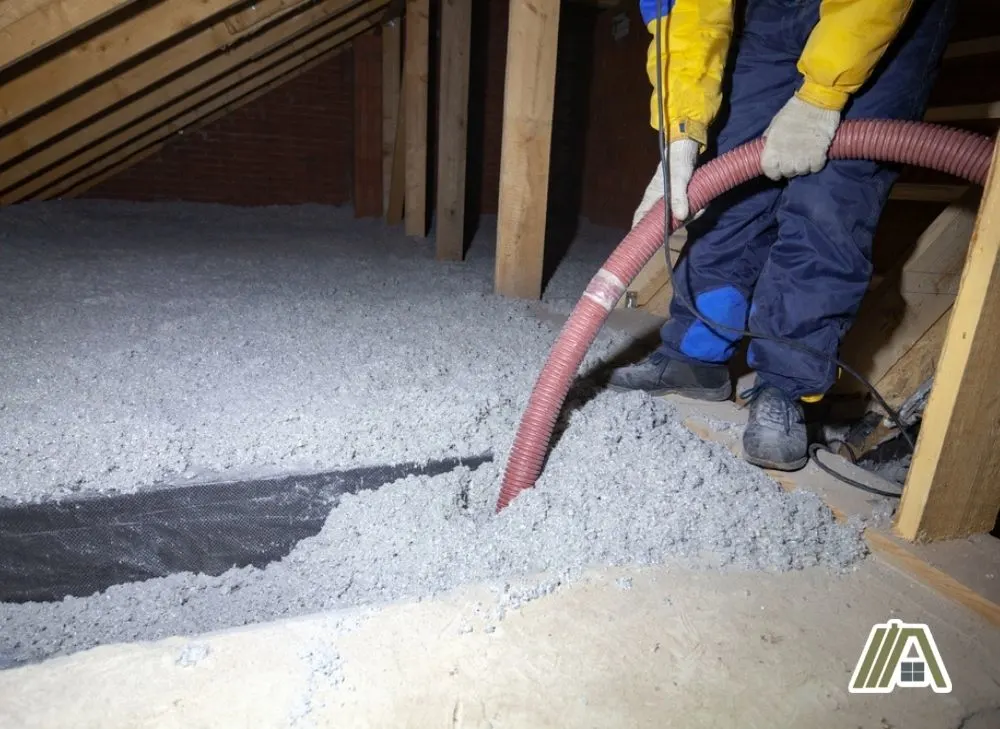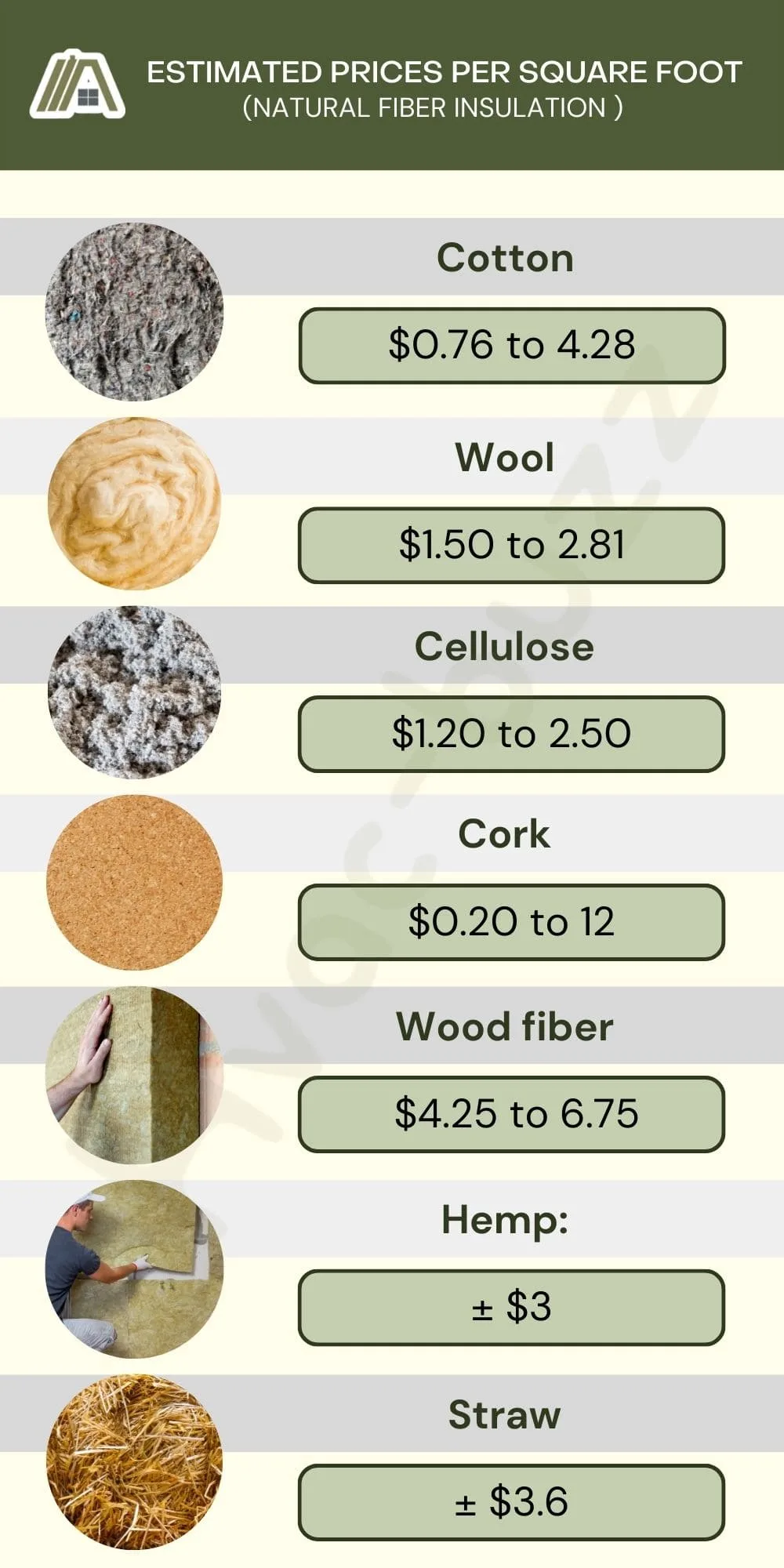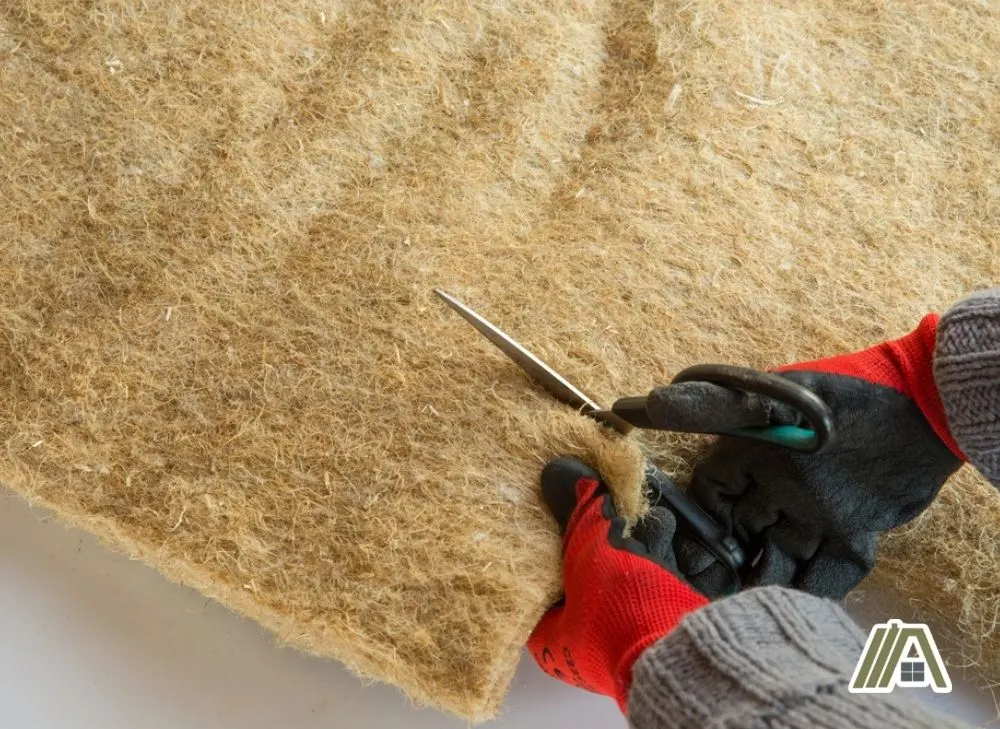Compete Take
As y'all get more aware of the importance of “going greenish” and making choices to conserve your health, y'all may reckon alternatives to synthetically produced products, similar insulation. They are available, although less good-known.
To help y'all brand your conclusion, hither we explicate natural fiber insulation, including its costs, pros, as well as cons, and so that yous tin live confident inwards your option.

Cotton, sheep wool, straw, hemp, wood fibers, cellulose, in addition to cork are available every bit natural insulation, coming inwards bales, batts, boards, and liberate-fill up. Inherent R-values reach from two-4.iii per inch, as well as price ranges from $0.2-12 per sq. ft. Natural fiber insulation is much safer to role.
What Is Natural Fiber Insulation?
Natural fiber insulation is comprised of just what is inwards the bring up: natural fibers.
These natural fibers may live sourced from plant or animate being materials.
Cotton insulation typically consists of 85% recycled cotton wool (often including recycled denim fibers) mixed alongside 15% plastic fibers.
Alternatively, batts of sheep wool or straw can grade natural fiber insulation.
Other less mutual forms of natural insulation in the the States are comprised of hemp in addition to forest fibers.
Cork tin live used, in addition to cellulose (consisting of recycled newspaper) may likewise live considered equally a type of natural fiber insulation.

These material are frequently recycled too treated with chemicals such equally borax to trim down the risk of burn, repel insects, together with bring down mold buildup.
Under average weather condition, such natural insulation material can concluding several decades, simply this depends on the location together with climate of where it is installed.
Appearance in addition to Use
Natural fiber insulation comes in various forms that expect similar the materials from which they are comprised.
Cotton insulation comes inward batts that are often blue/gray inwards colour, alongside fragments of cotton fiber and denim visible. This is similar to cellulose insulation (too available every bit liberate-make full too moisture-spray), inwards which fragments of newspaper are visible.
Similarly, sheep’s wool is available inward batts that are white, greyness, or dark-brown alongside a feature woolen appearance. It may as well be used every bit unloosen-fill up.
Straw may be used inward bale class or fused into boards with heavyweight kraft newspaper covering each side.
Cork, hemp, in addition to woods fiber insulation are also used every bit batts or stiff boards together with are brownish alongside textures feature of the materials.
Natural fiber insulation can be installed inward the same fashion equally synthetic insulation within floor, wall, and roof buildups.
Inherent R-Value of Natural Fiber Insulation
The R-value of a type of insulation determines how effective it is at preventing the transfer of rut. The higher the R-value, the more resistant it is to rut menses.
It is oft the case that liberate-make full insulation has a lower R-value than batts or boards of insulation.
Most synthetic insulation types accept an R-value ranging from two.5 to virtually 8 per inch of thickness.
The average R-values of common natural fiber insulation types range from near 2 to just over four per inch.
More specifically:
- Cellulose typically has R-values ranging from 3.2 to 3.8 per inch of thickness
- Sheep’s wool ranges from 3.half-dozen to iv.three, depending on the course used
- Hemp too cork take similar average R-values of around iii.vii per inch
- Cotton is slightly higher at three.8
- Straw has a lower R-value at merely nether 2 per inch.
Thickness Guide
To make up one's mind how thick insulation needs to live to obtain an R-rating, 1 can separate the target R-value past the R-value of the cloth.
The tabular array below gives a reach of the probable thicknesses of natural fiber insulation types needed to accomplish different overall R-ratings.
| Inches of insulation required to fulfill R-value target |
| Type of insulation | R30 | R38 | R40 | R49 | R50 | R60 |
| Cellulose | 7.ix to ix.4 | 10 to eleven.9 | x.5 to 12.five | 12.ix to 15.iii | xiii.two to 15.vi | fifteen.eight to eighteen.8 |
| Sheep’s wool | seven.0 to 8.three | 8.eight to ten.vi | ix.three to 11.i | 11.four to xiii.six | 11.vi to 13.9 | fourteen.0 to xvi.seven |
| Hemp/cork | eight.ane | 10.iii | ten.viii | 13.ii | thirteen.five | sixteen.ii |
| Cotton | vii.nine | 10 | ten.v | 12.9 | 13.2 | xv.eight |
| Straw | xv | nineteen | 20 | 24.5 | 25 | 30 |
Cost of Natural Fiber Insulation
For natural fiber insulation, in that location is a reach of prices for each type of material, which vary greatly depending on the type used (blown-inward vs. batt vs. boards, etc.).
The values provided here are a reach of estimated prices for each type of natural fiber insulation per foursquare human foot:
- Cotton: $0.76 to four.28
- Wool: $ane.50 to ii.81
- Cellulose: $ane.20 to two.fifty
- Cork: $0.20 to 12
- Wood fiber: $4.25 to vi.75
- Hemp: ± $three
- Straw: ± $iii.six

It is important to call up that fifty-fifty if a textile mightiness be cheaper per foursquare pes, it mightiness postulate much greater thicknesses to reach the desired R-value, so reckon this inwards your calculations.
Sale
Frost King CF1 "No Itch" Natural Cotton Multi-Purpose Insulation, 16 ten one ten 48-Inch
- Use For Insulating, Cushioning, And Noise Dampening
- Safe Alternative - No Gloves, Face Mask, Or Goggles Needed
- Cut Or Rip To Fit Pipes And Ducts, Walls, And Much More
- Brand Name: Frost King
Last update on 2023-04-15 / Affiliate links / Images from Amazon Product Advertising API
Is It Easy to Install?
The rest of installation depends on the fabric in addition to course used, only by and large, installation tin live easier inwards the sense that protective clothing as well as masks are not needed, too cleanup is simplified because the material are biodegradable.
In batt class, insulation, such every bit sheep’sec wool as well as cotton fiber, tin can be quite simple to install equally they tin can be cutting too trimmed to cast equally needed.
Blown-inwards forms, such as cellulose, can be installed using a suitable blower, but this may ask more complex procedures to prevent settling and other unwanted effects.
Rigid board forms, such as cork, tin can be tricky to cutting to tally about other areas amongst awkward angles.
Straw insulation tin can also be fairly easy to install, just this type of insulation may live best installed during menage structure, too non necessarily during renovation.
Is Natural Fiber Insulation Dangerous?
Since natural fiber insulation is made from natural materials, it is much safer than synthetic insulating material to function.
Although y'all might breathe inwards approximately fibers during installation, it is unlikely that this volition cause major wellness issues, and sure as shooting less and then than synthetic insulating materials.
Some natural fiber insulating material, such every bit hemp, tin live quite flammable, just they are oftentimes treated amongst burn down-retardant chemicals, including borax or ammonium sulfate, to minimize this take a chance.
While there may be concern that these fire-retardant chemicals themselves may be unsafe, in that location is piffling show to suggest this.
Sheep’s wool, hemp, or straw insulation may crusade allergic responses inwards sensitive individuals during installation, but this is unlikely to live crusade for major concern.
Benefits of Natural Fiber Insulation
Compared to other forms of insulation, natural fiber insulation types accept several advantages.
Firstly, they are easier as well as safer to grip, without the requirement for major protective gear.
Secondly, they are environmentally friendly every bit they require trivial free energy to make since they are derived from recycled materials, event in low carbon dioxide emissions, too are biodegradable.

They can too supply soundproofing qualities (and so you lot won’t have to endure through the neighbor’s dreaded violin rehearsals) in addition to provide electrical resistance.
Additionally, about types, such equally sheep’second wool, tin absorb moisture too trim condensation as well as may improve indoor air character by absorbing harmful gases.
Drawbacks of Natural Fiber Insulation
On the other hand, natural fiber insulation does accept a few negative characteristics to regard.
While near natural fiber insulation types tin can concluding for a few decades, they are non equally durable as synthetic insulation options.
Similarly, their power to absorb moisture may brand them more than prone to damage and swelling.
They can be more than flammable than other types of insulation (simply if they are treated alongside burn down-retardant chemicals, this shouldn’t live movement for concern).
Unfortunately, natural fiber insulations are oft more than expensive than other insulation types, too proper installation may ask thicker walls.
Sources
https://www.energystar.gov/sites/default/files/asset/document/Insulation%20Fact%20Sheet.pdf
https://www.homebuilding.co.uk/advice/natural-insulation
https://becgreen.ca/sheeps-wool-insulation-inward-batts-together with-unloose-make full/
https://www.energy.gov/energysaver/insulation-materials#natural
https://homeguide.com/costs/attic-insulation-price
https://www.homewyse.com/costs/cost_of_cotton_insulation.html
https://renoquotes.com/en/blog/insulation-toll
https://www.bre.co.uk/filelibrary/pdf/projects/low_impact_materials/IP18_11.pdf https://naturalwool-insulation.com/portfolio/tardily-to-install/

Komentar
Posting Komentar